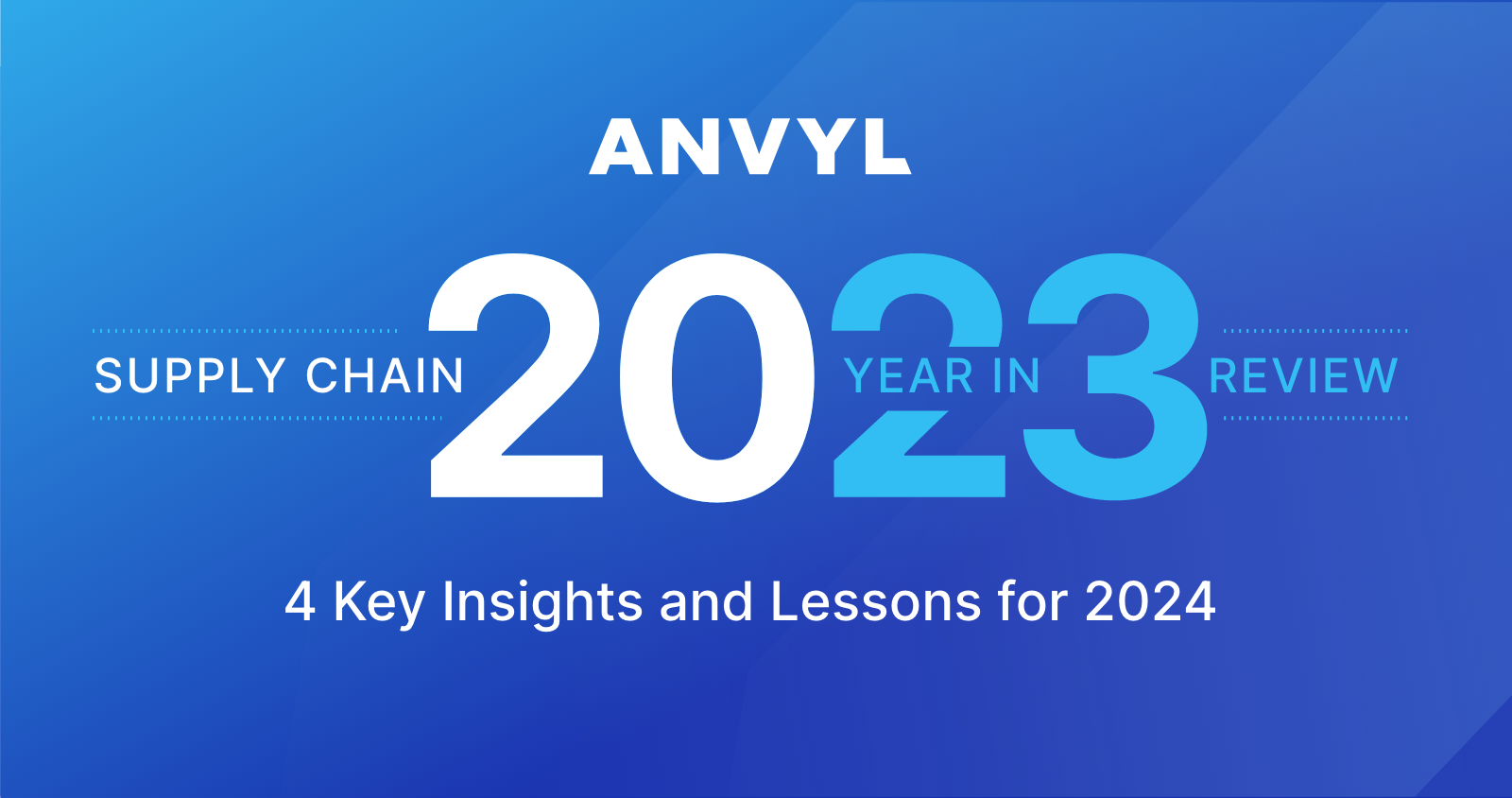As we bid farewell to 2023, it becomes crucial to reflect on what worked for supply chain managers, what didn’t work, and what lessons can fuel a successful new year. As we recap the intricacies of global supply chain challenges, this blog covers four supply chain lessons from this year.
From inventory glut to port strikes to the busiest Black Friday and Cyber Monday event ever, 2023 proved to be a monumental test for logistics, procurement, and distribution. It was also a year marked by significant opportunities for growth, spotlighting supply chain managers’ adaptability and sustainability as factors outside their control reshaped their industries.
Join us as we untangle the threads of global supply chains in 2023 and uncover key insights from the past year that will shape supply chain management in the New Year.
1. Inventory Glut Highlights Demand Forecasting Woes
Inventory glut – not shortages – edged its way into headlines in 2023. Retailers frequently delighted consumers with mega sales throughout the year, including Amazon, which threw two Prime Day events in just three months. While consumers responded with their wallets, these sales events weren’t just a sales tactic. They were a sign of retailers’ inventory management struggles and an overabundance of stock.
When Anvyl dug deep into the extent of the retail industry’s overstock problem, we found that it was a problem for 66% of brands in 2023. This represented a significant financial burden for them, tying up capital and eroding profit margins. This is likely why brands held more sales in 2023, as they were under pressure to liquidate surplus stock.
In fact, according to Anvyl’s research, 22% of brands with extra inventory offered sales and discounts in 2023, 24% donated overstock to charities, and 28% sold excess inventory to liquidators or other third-party buyers.
These issues demand better data-driven demand forecasting in 2024. By analyzing historical sales data, market trends, and customer behavior patterns, brands can make better decisions about production and inventory levels. This minimizes the risk of overstock, ensuring you meet consumer demands without accumulating excess inventory.
2. Omnichannel Growth Demands Automated PO Management
2023 also spotlighted a surging wave of omnichannel growth. As consumer spending posted significant gains throughout the year, 73% of brands surveyed by Anvyl planned to capitalize by scaling into a new channel.
While brands’ shift to an omnichannel strategy is a positive sign of growth, it introduces new supply chain challenges. It specifically demands an automated purchase order (PO) management process as supply chain managers navigate an increase in the:
- Number of purchase orders to submit
- Volumes suppliers produce
- Shipments to track
- Locations to ship
- Number of SKUs to track
Yet, only 25% of businesses say they use a PO management solution to track POs, according to Anvyl’s data. In fact, 67% still use Excel!
Supply chain managers must prioritize PO automation in 2024 to ensure successful omnichannel growth. PO automation provides a range of benefits, including:
- Enhanced data entry accuracy: Automation eliminates the need for manual data entry and paper-based processes. This significantly reduces the risk of human errors and inconsistencies.
- Real-time supply chain insights: Automation offers real-time visibility into inventory levels, order statuses, and supply chain operations. This allows you to identify potential delays early and proactively mitigate them.
- Faster and confident decision-making: Automated PO solutions contain a wealth of data brands can harness for informed decision-making across your supply chain.
- Improved and more transparent supplier relationships: Automated systems cultivate more transparent and collaborative relationships with suppliers, promoting effective communication and streamlined processes within the supply chain.
3. Rise in Cost of Goods Emphasizes Crucial Role of Supplier Relationships
31% of brands report that they saw the cost of goods increase by 5-10% in 2023. An additional third say they experienced an increase of 10-20% or more, according to an Anvyl study conducted before the 2023 holiday shopping season.
This rise in the cost of goods underscores the value of great supplier relationships. While suppliers often need to increase their prices in times of high inflation, strong buyer-supplier partnerships can help alleviate pressure on brands. This is because supplier relationships can enable:
- Open communication channels: Buyers and suppliers can strategize effectively in response to shifting market conditions. This level of transparency allows for a mutual understanding of challenges and opportunities during hard economic times, allowing both parties to collaborate and problem-solve more effectively.
- Better negotiations: Suppliers may be more inclined to work with a buyer to find a solution that optimizes costs and enhances the overall value proposition.
- Supply chain resilience: Suppliers invested in the success of their buyers are more likely to proactively address potential risks, ensuring continuity and reliability in the face of economic challenges.
Building better supplier relationships should be a strategic imperative for every supply chain team in 2024. Robust supplier relationships ensure a stable and reliable supply chain and position brands to achieve sustained success in an unpredictable market.
4. Brands Diversify Suppliers and Pivot to Nearshoring
Geopolitical tensions and trade disputes underwent seismic shifts in 2023. This pushed brands to the crossroads of uncertainty and compelled them to restructure their supplier networks.
When Anvyl surveyed 650 business owners and executives in May 2023, 71% said they had plans to diversify their product sourcing. A significant reason behind this move was to de-risk the impact of geopolitical tensions.
It’s evident, however, that supplier diversification isn’t merely a reactive measure but a strategic imperative for 2024 and beyond. At Anvyl, many DTC brands pivoted to nearshoring to protect their supply chains. We expect this to continue in 2024.
Nearshoring is when a brand works with a supplier in a nearby country. It not only helps mitigate risks but also offers advantages such as reduced lead times, improved communication, and increased flexibility.
Do you want to fortify your supply chain in 2023? Contact our team to learn why brands like Native, Brooklinen, and COOLA invest in Anvyl’s supply chain visibility platform.



